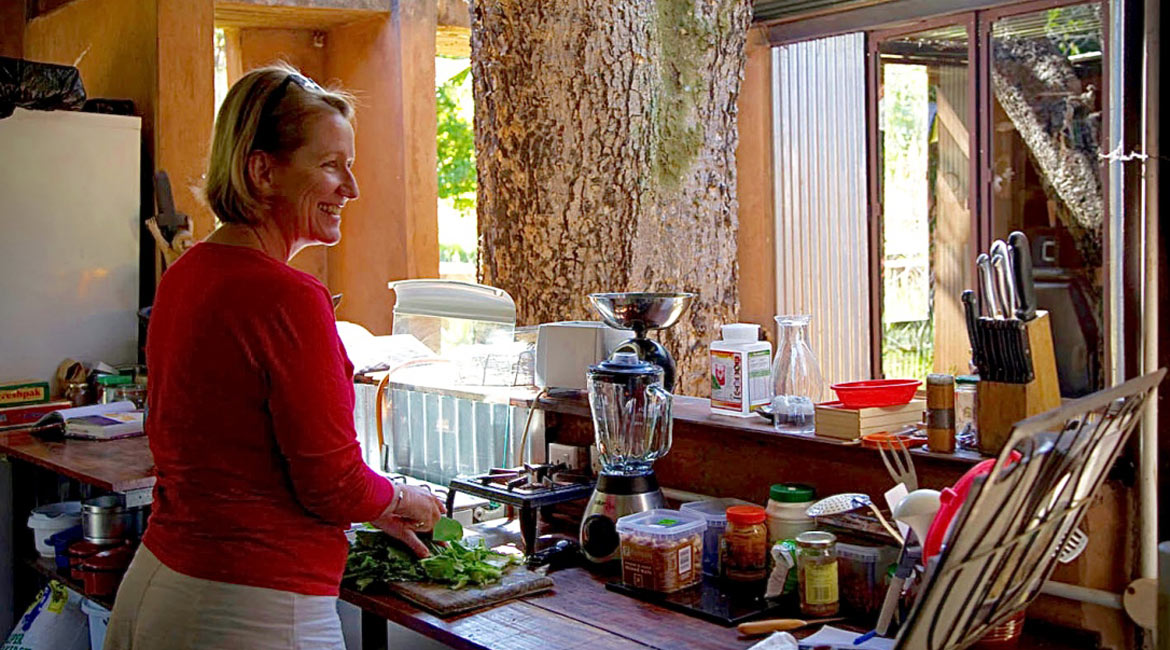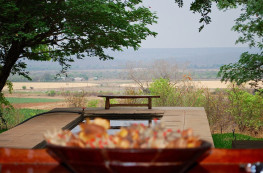Since I published my last blog post UNDER THE MONGONGO TREE – Bush Gourmet in the Zambezi Valley – A Prologue, many readers — particularly those with a slow internet connection — have written in to say they struggled to open the feature article in The Cook’s Cook magazine. It was a singular opportunity for me that I really wanted to share with all my readers, therefore I have reproduced the story below. The feature article also included my recipes for Bush Biscotti and a Sacred Salad.
“Land is the place where lessons are taught, where Wisdom abides; where we learn lessons about life and death from the seed broken open in darkness, dying in order to come to life in a different form, and from the compost which teaches us that decay is needed for life’s richness. Land is the place where we are healed when no words can comfort or explain. It is the place where we are taught about and find community; where everything is connected to everything else, and nothing exists independently; the place where everything feeds on and depends on the other.”
I borrowed this quote from a Dominican Sister in Long Island, New York, to illustrate a concept document I drafted in 2009 when I lived in a small hamlet in Virginia. I had envisioned turning forty-three acres of unused land beyond my house, beneath the Blue Ridge Mountains, into a healing retreat and organic garden for those “in need of peace, reflection, and nourishment.”
It was an ambitious vision, one which I thought was my life’s calling. Today that sanctuary is built and operational. My concept document turned into a rural retreat for wounded veterans, only it did so without me. One year into the project, the investor I secured to help manifest my vision took it away from me. With it he took away my connection to the place in which I’d bought my first house, in an adopted country in which I believed I belonged.
America gave me my dreams but she also took them away.
What wasn’t taken away from me was my reverence for the natural world. Nor my love for growing things and feeding people. I decided to return to Africa, the continent that grew me. Before I moved back I pared myself down to nothing. I dissolved all my expectations, I sold or gave away all my belongings. I never wished to bear such weight again. On the outside or the inside.
 The empty, white landscape I ended up in, Botswana’s Kalahari Desert—a place so flat you can see the curvature of the earth’s surface—reflected that nothingness. I’d traveled there to sate the aspiring naturalist in me, and in particular to learn about wild food from the San Bushmen. But a tragedy in my family cut short my time in the desert, and I moved to a farm in Zambia’s Zambezi Valley, a few miles upriver from Victoria Falls in Livingstone. Here, I gave up running from my aloneness and fell in love.
The empty, white landscape I ended up in, Botswana’s Kalahari Desert—a place so flat you can see the curvature of the earth’s surface—reflected that nothingness. I’d traveled there to sate the aspiring naturalist in me, and in particular to learn about wild food from the San Bushmen. But a tragedy in my family cut short my time in the desert, and I moved to a farm in Zambia’s Zambezi Valley, a few miles upriver from Victoria Falls in Livingstone. Here, I gave up running from my aloneness and fell in love.
When I moved in with my partner Chris two years ago, we committed to embrace a way of living fused in the “principle of enoughness,” a phrase coined by Ghandi, and a norm for indigenous people like the San Bushmen. As it was, we’d each been pushed towards living “sufficiently.” The preceding years had been tough for both of us, on many levels—Chris living here in Zambia and me in the U.S. There’s nothing like scarcity to make you forage deep into your creative resources. In my kitchen in Virginia I’d make wild pesto out of garlic mustard, a ubiquitous invasive weed that surrounded my boundary. I’d make jam out of wineberries, harvested from vines scrambling up and down the sides of the road running past my house.
Here we are forever improvising or “making a plan”—a truism common throughout southern Africa—be it building a room using bricks made on the farm, or fashioning gadgets to be used in the garden. We recycle where we can, and we fix what is broken. We eat out of the garden and we eat wild edibles. We support our local food producers as much as we are able, and we do our best not to be wasteful.
 Living simply does not mean we live without aesthetics. Chris designed and built our house borrowing principles from Australian architect Glenn Murcutt, known for marrying “modern architecture to the place, the territory, the landscape.” Built beneath the canopy of a native Mongongo tree and made from corrugated sheeting and steel girders, it cost Chris a total of $5,700.
Living simply does not mean we live without aesthetics. Chris designed and built our house borrowing principles from Australian architect Glenn Murcutt, known for marrying “modern architecture to the place, the territory, the landscape.” Built beneath the canopy of a native Mongongo tree and made from corrugated sheeting and steel girders, it cost Chris a total of $5,700.
I see it as a deceptive wonder. Its elemental design—there are no doors and few windows—brings the outside inside. Its simplicity and openness allow for unfettered access to the natural world beyond. While this gives us the privilege of bird watching from our sofa, it also keeps nothing out. The corrugated walls are articulated to allow for air to pass through unencumbered. And the rain during the wet months. And the heat. And the bugs. Sometimes a rat, sometimes a snake in pursuit of an easy meal or a warm place to hunker down in winter.
Living as we do forces one to slow right down. It makes you observant and keeps you mindful. Neither of us pretends it isn’t tough at times. Lightning blows up electrics, we’re stung or bitten, dust storms blanket the furniture and scatter leaves throughout the house. Just try preparing dinner beneath a light swarming with little black stink bugs or flying ants! Yet it’s cyclical. Everything comes and goes. Birds migrate. The critters die back with the landscape at the end of the rains.
Living simply does not mean we don’t eat well, either. It’s made me resourceful and creative in the kitchen, relying much on what we grow or forage. So many ingredients I used to take for granted living in the United States aren’t available here in Livingstone. Our two grocery stores, 15 miles away from the farm, are basic in comparison to those found in the West. The choice is limited, which is good. I use my imagination instead.
 When I first arrived on the farm, Chris’s garden weighed heavy with citrus, pomegranates, pineapples and papaya. The mango trees had just finished fruiting, and the galangal and turmeric were soon to be dug up. Wild rosella plants were being harvested, dried, and ground into tea, and I learned that the native woodland surrounding us was filled with wild edibles. The Zambian people with whom I work have taught me so much about what is edible and what is poisonous. Today wild food plays a growing role in the recipes I develop.
When I first arrived on the farm, Chris’s garden weighed heavy with citrus, pomegranates, pineapples and papaya. The mango trees had just finished fruiting, and the galangal and turmeric were soon to be dug up. Wild rosella plants were being harvested, dried, and ground into tea, and I learned that the native woodland surrounding us was filled with wild edibles. The Zambian people with whom I work have taught me so much about what is edible and what is poisonous. Today wild food plays a growing role in the recipes I develop.
The vegetable garden has expanded since my arrival. I’m willing to try and grow anything. Mostly we’ve been successful, for three fundamental reasons: we have the space, we employ knowledgeable Zambians to help us, and we have access to an unlimited water supply from the Zambezi River, which ensures that working the semi-arid Kalahari soils, in extreme diurnal temperatures, is possible. The same applies to the farm, although Chris and his team have the additional challenge of keeping migrating herds of hungry elephants away from the winter crops. (Elephants have visited the house in times gone by, too, decimating the vegetable garden while terrifying Chris in the middle of the night with loud trumpeting!)
 My bush kitchen doesn’t have windows. I share it with transient lizards, mice, frogs, birds, and myriad bugs whose appearances rotate according to the seasons. For this reason our kitchen equipment and foodstuffs are all put away in closed cupboards, containers and freezers. I cook on gas, electric, or over a fire, depending on what is available at the time.
My bush kitchen doesn’t have windows. I share it with transient lizards, mice, frogs, birds, and myriad bugs whose appearances rotate according to the seasons. For this reason our kitchen equipment and foodstuffs are all put away in closed cupboards, containers and freezers. I cook on gas, electric, or over a fire, depending on what is available at the time.
My equipment is mostly donated or old, although modern gadgets, like my new ice cream maker, are starting to appear when my growing food business demands it. Not long after I moved here I unearthed an 80s-model electric mixer from a forgotten kitchen basket to make a dessert, only to discover mud wasps had turned the holes for the beater paddles into two towers of high-rise condos. The squatters had left by the time I came to use it, so I poked the mud out of each hole with a stick, and the mixer cranked up again, like new.
For me, one of the best outcomes of living as we do is the ingenuity it’s induced in my recipe development. As I’ve turned to the garden and to the wild for ingredients, I’ve become more and more inspired. And it shows: last year we were asked by local tour operators to offer Farm & Food tours, which is now a growing business. My blog SavannaBel is the vehicle I use to showcase our life here, as well as the recipes I create or adapt. Chris, with his sophisticated palate and innate sensibility, is a keen tester and participant. He also happens to be a terrific cook.
How could I have known that a quote I once borrowed to illustrate a vision I had for a piece of land in Virginia would later re-echo so clearly out here in the African bush? … “Land is the place where lessons are taught, where Wisdom abides; where we learn lessons about life and death from the seed broken open in darkness, dying in order to come to life in a different form…” Nature is miraculous.





18 Comments
Simply beautiful. Thanks for sharing, Annabel. Your colorful account of your journey back to Africa and current life “on the farm,” allows us all a delightful peek into your world. Hope to visit, one day. Congrats on the high-tech addition of an ice-cream maker!
xoxo
Courtney
Thank you, dear Courtney. What a journey it has been! We hope you visit, too. And to be sure, ice cream will be on the menu! xoxo
A moving account of your resilience Annabel! I believe our Maker has plans for us that we don’t always appreciate at the time.
Thank you, Colin. In those times when one’s life is turned upside down, resistance often seems to make it worse. When you are forced to let go … when you eventually throw up your hands in surrender … dreams can come true, corny as that may sound. I am living proof. How grateful I am!
Annabel, this is so beautifully written and moving. Thank you for sharing xxx
What a really kind comment … thank you.
Thanks for posting up the full article – I don’t think I found that first time but always planned to come back and have another go – the introduction kept me happy until then. Really interesting to see inside your house and kitchen! I salute you for sharing floor space with all that Africa’s storms and dry winds blow to and fro – I know that can get exciting even with doors. Love seeing you in your working environment … really adds the dimension of emotion and shadows. Brava!
Thank you, Georgie. I hope one day you and your lovely family will join us on the slab, as our floor space is called. Your support and interest means a great deal to me. xo
Moving and inspiring and one day I would love to visit you two, introduce you to Rozanne, and cook Chris a Curry again and give him a ‘Crit’ on his Architecture ! 😀
Thank you for your kind comment, John. We look forward to your visit! All the best to you and Rozanne, Annabel
What a beautiful piece, Annabel. It was a pleasure to read and it lingers with me, inspiring.
Thank you for your very kind comment. I am so fortunate to live in such an abundant place. All the best to you, Annabel
Dear Annabel – I somehow came across your blog through my cousins Roger and Graeme Bolton. I just love the way you write and I always look forward to your next article. You really are living the dream! Warm regards Bev Fraser -Bolton
Dear Bev … what a super-kind comment. Thank you for your support and interest. When I hear from people I do not know, like you, it makes blogging all the more satisfying. All the best and thanks again, Annabel
P.S. I LOVE your cousins!
That is a well written explanation of your current lifestyle. I am assuming that Chris is the one I know and is the same Chris that has been joined by Simon. If so , they will identify me and I would like them to know that the family is delighted with the news. Well done Savannabel.
Thank you very much, Michael! Aston bros. think they can identify you, but aren’t 100% sure! All the best to you, Annabel
Your writings are like little travel tickets to places I adore to be in – mainly the bush of course – and where I can sneak off to in between the mundane office ‘stuff’ of every day – lizards and leaves, mice and spiders, ants and egg whites – all perfectly blended and folded into the recipe of Life in Africa…..LOVE IT ALL!!!!
What a really thoughtful comment, Lin. Thank you. Writing my blog is made all the better when I receive this sort of feedback. The African bush is indeed a magical place, and how lucky I am to be in amongst it all. All the best to you, Annabel
Comments are closed.